Market Research and Analysis: Nike Inc. Australia Expansion Plan
VerifiedAdded on 2020/03/07
|15
|4305
|831
Report
AI Summary
This report provides a comprehensive market research and analysis of Nike Inc., focusing on its potential expansion into the Australian market. It begins with an introduction to Nike, highlighting its global presence and product offerings. The report then delves into the marketing environment, examining changes in consumer trends, tastes, and preferences, as well as the impact of technology. A SWOT analysis is conducted to assess Nike's strengths, weaknesses, opportunities, and threats in the Australian context. Furthermore, the report explores market segmentation, detailing demographic, geographic, behavioristic, and psychographic variables used by Nike. The analysis concludes by discussing the most viable market research strategy for Nike Inc. in Australia, considering the competitive landscape and consumer behavior. The report emphasizes the importance of understanding the local market dynamics to ensure successful market entry and growth.
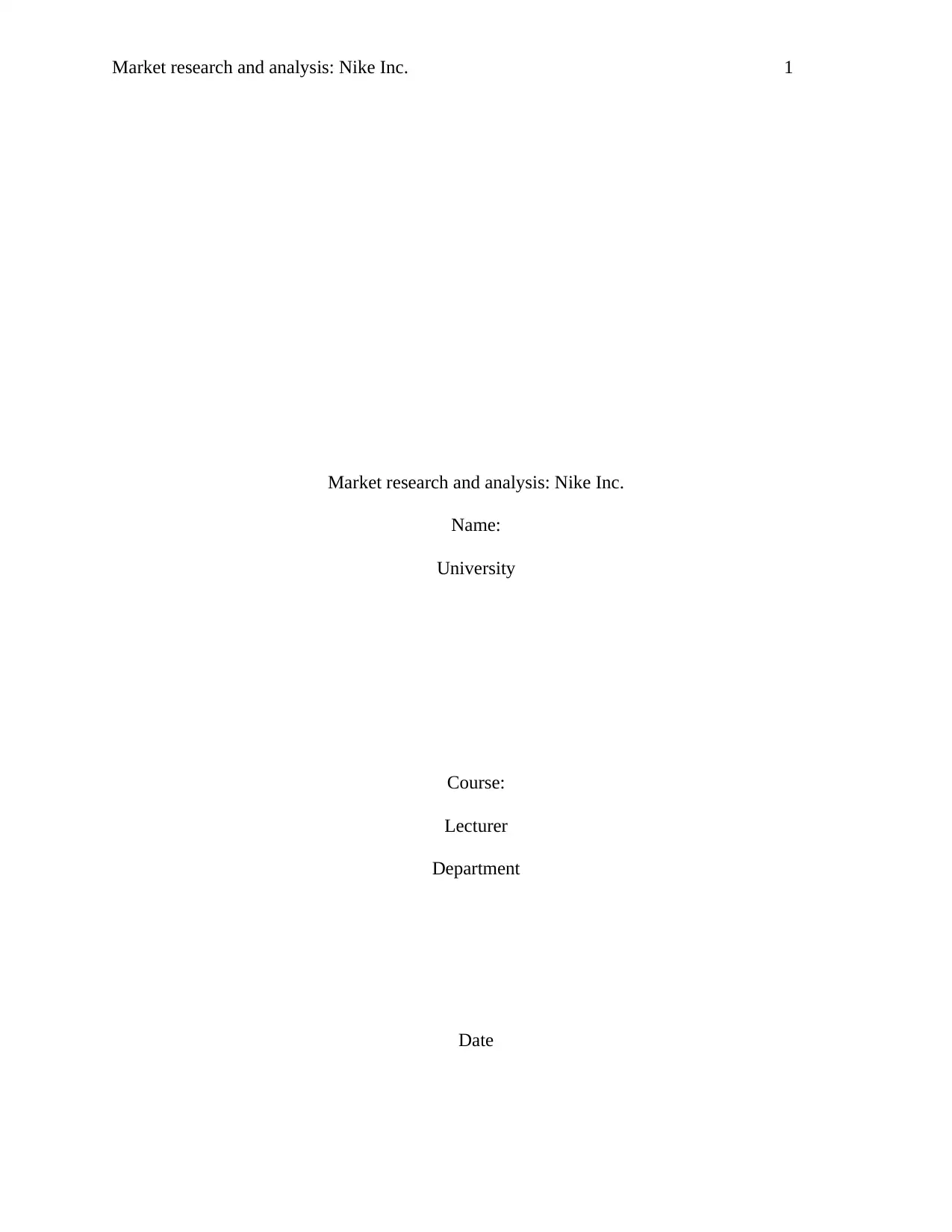
Market research and analysis: Nike Inc. 1
Market research and analysis: Nike Inc.
Name:
University
Course:
Lecturer
Department
Date
Market research and analysis: Nike Inc.
Name:
University
Course:
Lecturer
Department
Date
Paraphrase This Document
Need a fresh take? Get an instant paraphrase of this document with our AI Paraphraser
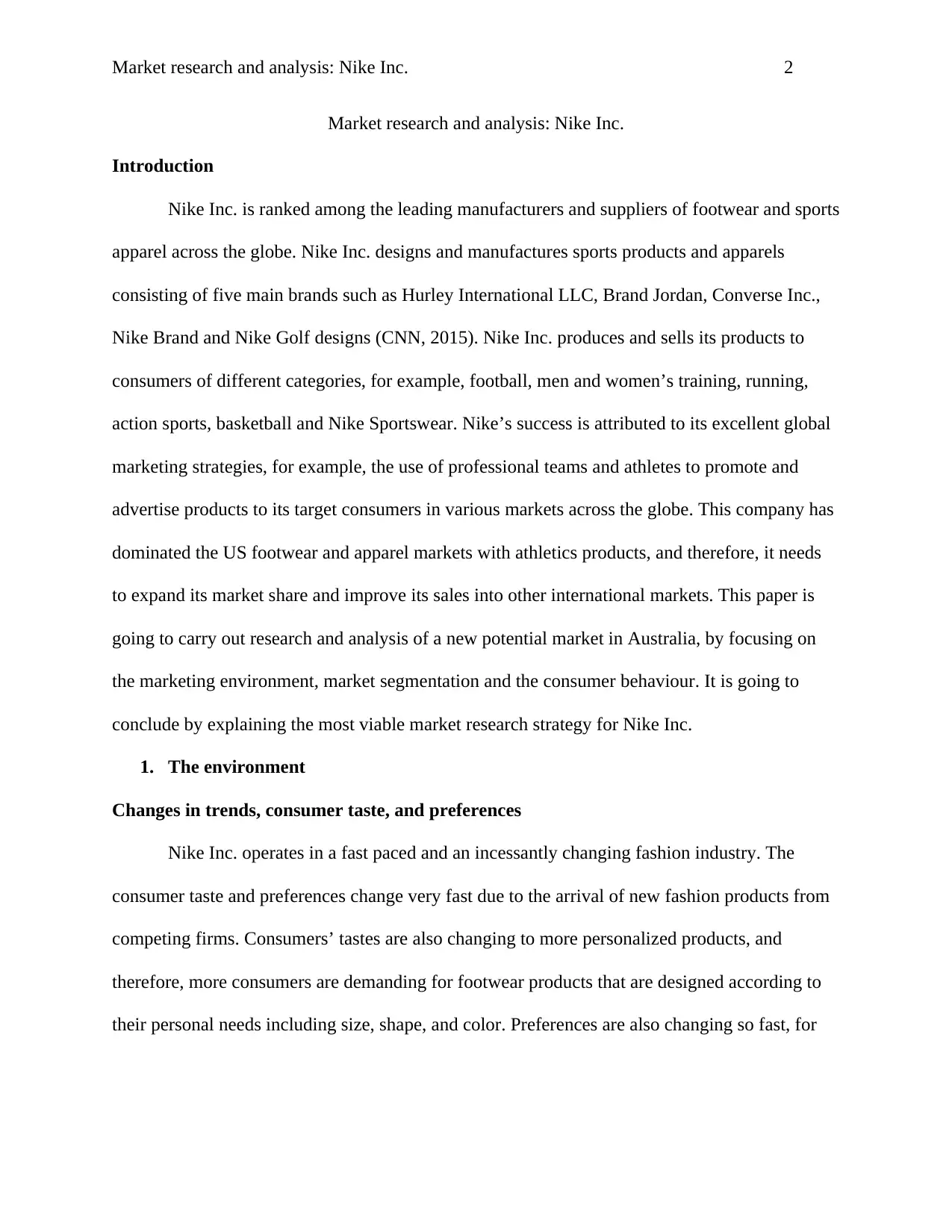
Market research and analysis: Nike Inc. 2
Market research and analysis: Nike Inc.
Introduction
Nike Inc. is ranked among the leading manufacturers and suppliers of footwear and sports
apparel across the globe. Nike Inc. designs and manufactures sports products and apparels
consisting of five main brands such as Hurley International LLC, Brand Jordan, Converse Inc.,
Nike Brand and Nike Golf designs (CNN, 2015). Nike Inc. produces and sells its products to
consumers of different categories, for example, football, men and women’s training, running,
action sports, basketball and Nike Sportswear. Nike’s success is attributed to its excellent global
marketing strategies, for example, the use of professional teams and athletes to promote and
advertise products to its target consumers in various markets across the globe. This company has
dominated the US footwear and apparel markets with athletics products, and therefore, it needs
to expand its market share and improve its sales into other international markets. This paper is
going to carry out research and analysis of a new potential market in Australia, by focusing on
the marketing environment, market segmentation and the consumer behaviour. It is going to
conclude by explaining the most viable market research strategy for Nike Inc.
1. The environment
Changes in trends, consumer taste, and preferences
Nike Inc. operates in a fast paced and an incessantly changing fashion industry. The
consumer taste and preferences change very fast due to the arrival of new fashion products from
competing firms. Consumers’ tastes are also changing to more personalized products, and
therefore, more consumers are demanding for footwear products that are designed according to
their personal needs including size, shape, and color. Preferences are also changing so fast, for
Market research and analysis: Nike Inc.
Introduction
Nike Inc. is ranked among the leading manufacturers and suppliers of footwear and sports
apparel across the globe. Nike Inc. designs and manufactures sports products and apparels
consisting of five main brands such as Hurley International LLC, Brand Jordan, Converse Inc.,
Nike Brand and Nike Golf designs (CNN, 2015). Nike Inc. produces and sells its products to
consumers of different categories, for example, football, men and women’s training, running,
action sports, basketball and Nike Sportswear. Nike’s success is attributed to its excellent global
marketing strategies, for example, the use of professional teams and athletes to promote and
advertise products to its target consumers in various markets across the globe. This company has
dominated the US footwear and apparel markets with athletics products, and therefore, it needs
to expand its market share and improve its sales into other international markets. This paper is
going to carry out research and analysis of a new potential market in Australia, by focusing on
the marketing environment, market segmentation and the consumer behaviour. It is going to
conclude by explaining the most viable market research strategy for Nike Inc.
1. The environment
Changes in trends, consumer taste, and preferences
Nike Inc. operates in a fast paced and an incessantly changing fashion industry. The
consumer taste and preferences change very fast due to the arrival of new fashion products from
competing firms. Consumers’ tastes are also changing to more personalized products, and
therefore, more consumers are demanding for footwear products that are designed according to
their personal needs including size, shape, and color. Preferences are also changing so fast, for
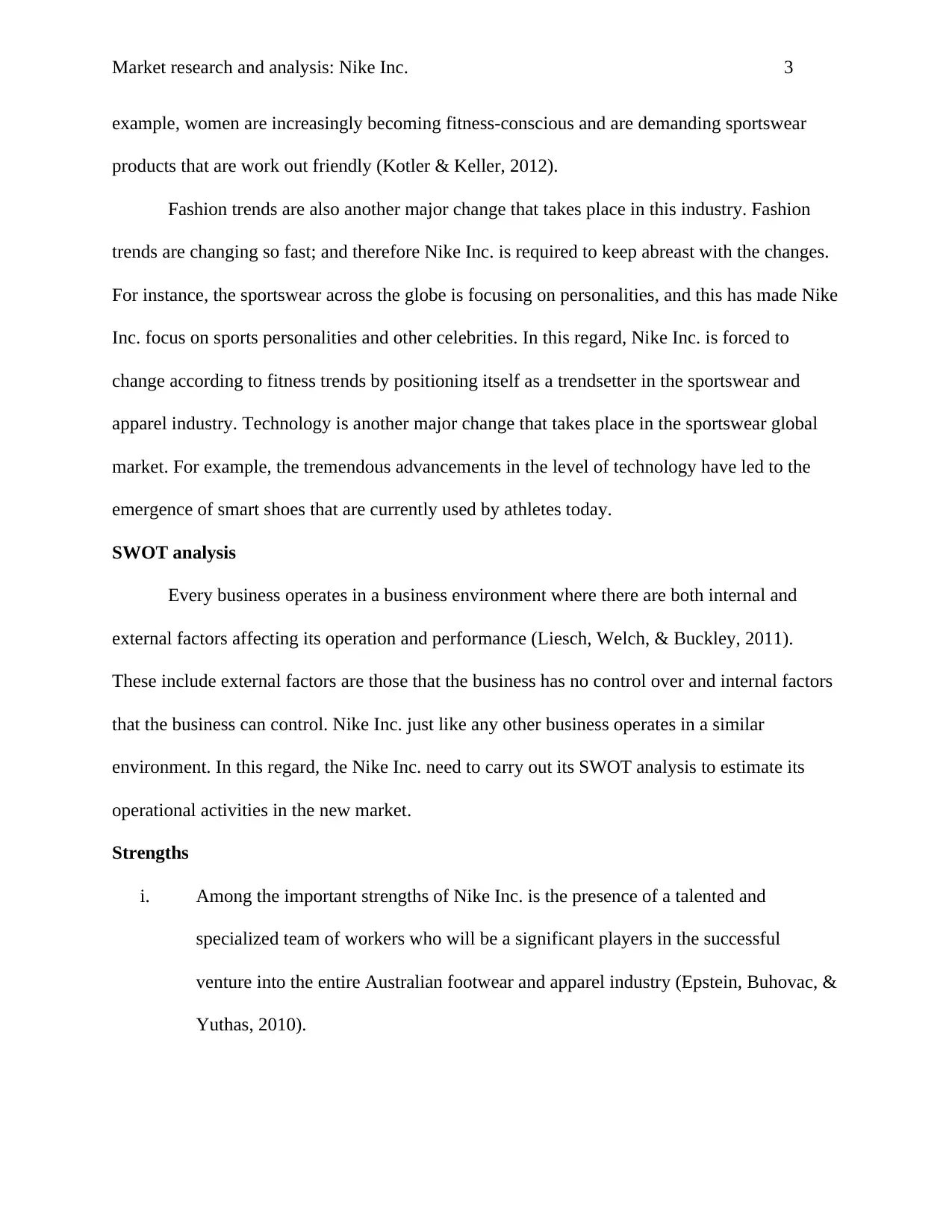
Market research and analysis: Nike Inc. 3
example, women are increasingly becoming fitness-conscious and are demanding sportswear
products that are work out friendly (Kotler & Keller, 2012).
Fashion trends are also another major change that takes place in this industry. Fashion
trends are changing so fast; and therefore Nike Inc. is required to keep abreast with the changes.
For instance, the sportswear across the globe is focusing on personalities, and this has made Nike
Inc. focus on sports personalities and other celebrities. In this regard, Nike Inc. is forced to
change according to fitness trends by positioning itself as a trendsetter in the sportswear and
apparel industry. Technology is another major change that takes place in the sportswear global
market. For example, the tremendous advancements in the level of technology have led to the
emergence of smart shoes that are currently used by athletes today.
SWOT analysis
Every business operates in a business environment where there are both internal and
external factors affecting its operation and performance (Liesch, Welch, & Buckley, 2011).
These include external factors are those that the business has no control over and internal factors
that the business can control. Nike Inc. just like any other business operates in a similar
environment. In this regard, the Nike Inc. need to carry out its SWOT analysis to estimate its
operational activities in the new market.
Strengths
i. Among the important strengths of Nike Inc. is the presence of a talented and
specialized team of workers who will be a significant players in the successful
venture into the entire Australian footwear and apparel industry (Epstein, Buhovac, &
Yuthas, 2010).
example, women are increasingly becoming fitness-conscious and are demanding sportswear
products that are work out friendly (Kotler & Keller, 2012).
Fashion trends are also another major change that takes place in this industry. Fashion
trends are changing so fast; and therefore Nike Inc. is required to keep abreast with the changes.
For instance, the sportswear across the globe is focusing on personalities, and this has made Nike
Inc. focus on sports personalities and other celebrities. In this regard, Nike Inc. is forced to
change according to fitness trends by positioning itself as a trendsetter in the sportswear and
apparel industry. Technology is another major change that takes place in the sportswear global
market. For example, the tremendous advancements in the level of technology have led to the
emergence of smart shoes that are currently used by athletes today.
SWOT analysis
Every business operates in a business environment where there are both internal and
external factors affecting its operation and performance (Liesch, Welch, & Buckley, 2011).
These include external factors are those that the business has no control over and internal factors
that the business can control. Nike Inc. just like any other business operates in a similar
environment. In this regard, the Nike Inc. need to carry out its SWOT analysis to estimate its
operational activities in the new market.
Strengths
i. Among the important strengths of Nike Inc. is the presence of a talented and
specialized team of workers who will be a significant players in the successful
venture into the entire Australian footwear and apparel industry (Epstein, Buhovac, &
Yuthas, 2010).
⊘ This is a preview!⊘
Do you want full access?
Subscribe today to unlock all pages.

Trusted by 1+ million students worldwide
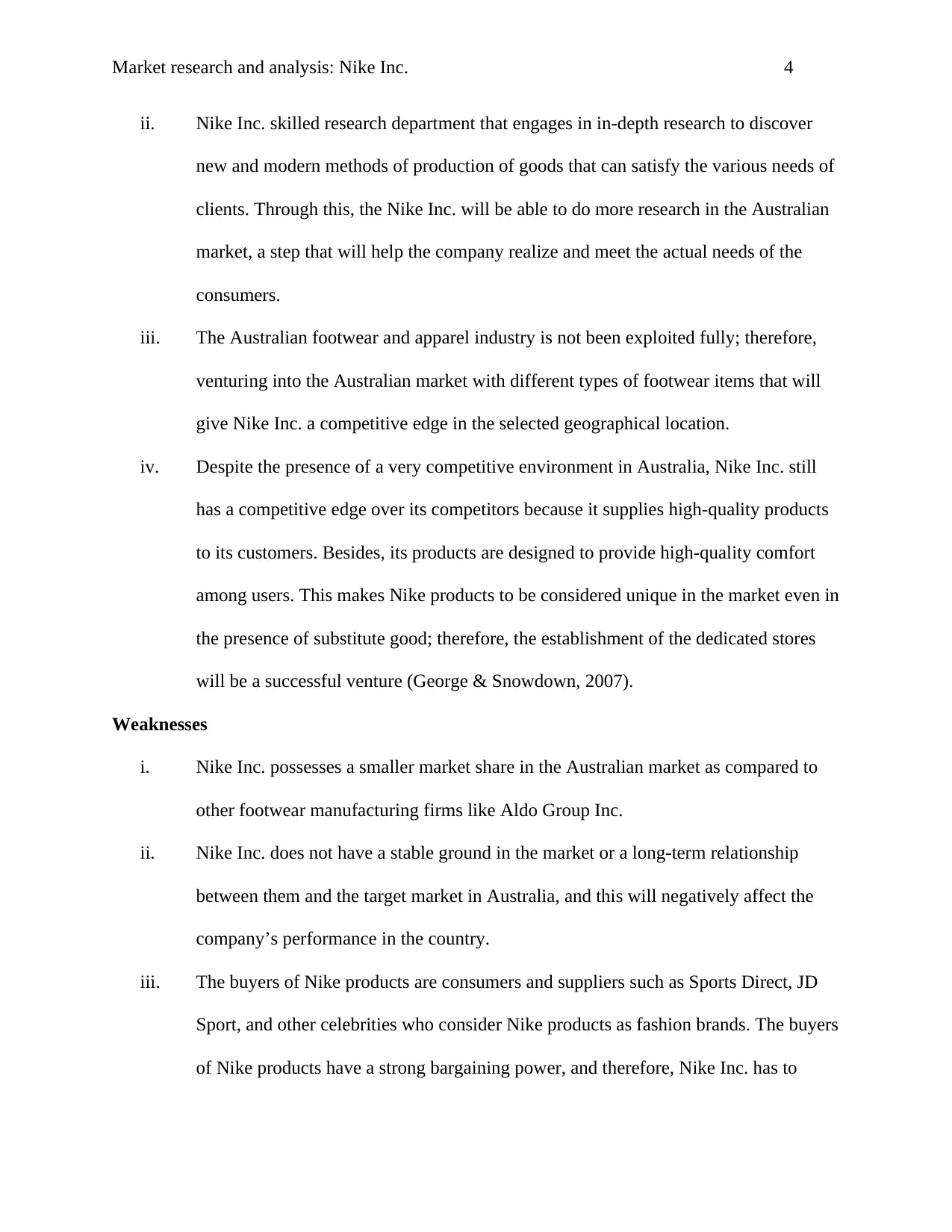
Market research and analysis: Nike Inc. 4
ii. Nike Inc. skilled research department that engages in in-depth research to discover
new and modern methods of production of goods that can satisfy the various needs of
clients. Through this, the Nike Inc. will be able to do more research in the Australian
market, a step that will help the company realize and meet the actual needs of the
consumers.
iii. The Australian footwear and apparel industry is not been exploited fully; therefore,
venturing into the Australian market with different types of footwear items that will
give Nike Inc. a competitive edge in the selected geographical location.
iv. Despite the presence of a very competitive environment in Australia, Nike Inc. still
has a competitive edge over its competitors because it supplies high-quality products
to its customers. Besides, its products are designed to provide high-quality comfort
among users. This makes Nike products to be considered unique in the market even in
the presence of substitute good; therefore, the establishment of the dedicated stores
will be a successful venture (George & Snowdown, 2007).
Weaknesses
i. Nike Inc. possesses a smaller market share in the Australian market as compared to
other footwear manufacturing firms like Aldo Group Inc.
ii. Nike Inc. does not have a stable ground in the market or a long-term relationship
between them and the target market in Australia, and this will negatively affect the
company’s performance in the country.
iii. The buyers of Nike products are consumers and suppliers such as Sports Direct, JD
Sport, and other celebrities who consider Nike products as fashion brands. The buyers
of Nike products have a strong bargaining power, and therefore, Nike Inc. has to
ii. Nike Inc. skilled research department that engages in in-depth research to discover
new and modern methods of production of goods that can satisfy the various needs of
clients. Through this, the Nike Inc. will be able to do more research in the Australian
market, a step that will help the company realize and meet the actual needs of the
consumers.
iii. The Australian footwear and apparel industry is not been exploited fully; therefore,
venturing into the Australian market with different types of footwear items that will
give Nike Inc. a competitive edge in the selected geographical location.
iv. Despite the presence of a very competitive environment in Australia, Nike Inc. still
has a competitive edge over its competitors because it supplies high-quality products
to its customers. Besides, its products are designed to provide high-quality comfort
among users. This makes Nike products to be considered unique in the market even in
the presence of substitute good; therefore, the establishment of the dedicated stores
will be a successful venture (George & Snowdown, 2007).
Weaknesses
i. Nike Inc. possesses a smaller market share in the Australian market as compared to
other footwear manufacturing firms like Aldo Group Inc.
ii. Nike Inc. does not have a stable ground in the market or a long-term relationship
between them and the target market in Australia, and this will negatively affect the
company’s performance in the country.
iii. The buyers of Nike products are consumers and suppliers such as Sports Direct, JD
Sport, and other celebrities who consider Nike products as fashion brands. The buyers
of Nike products have a strong bargaining power, and therefore, Nike Inc. has to
Paraphrase This Document
Need a fresh take? Get an instant paraphrase of this document with our AI Paraphraser
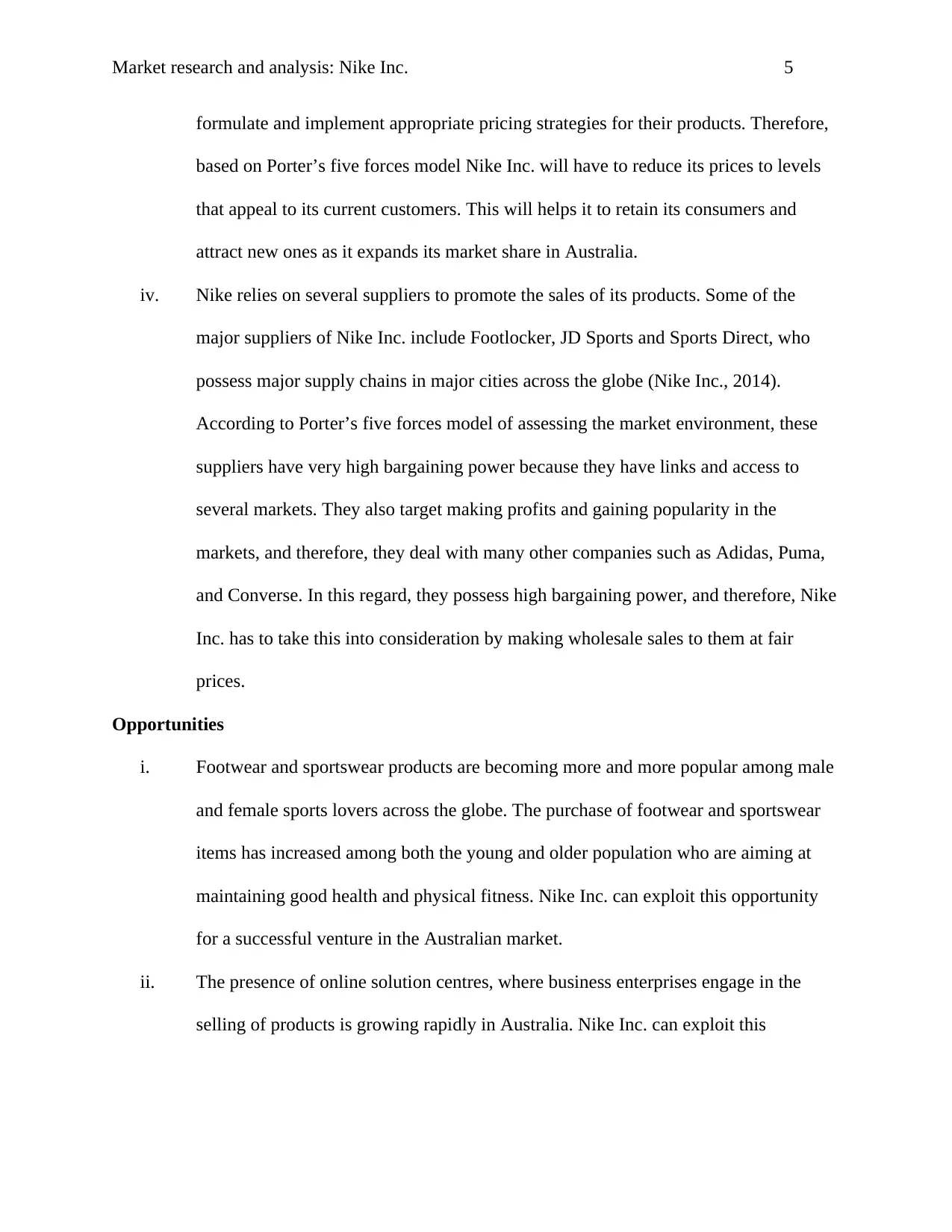
Market research and analysis: Nike Inc. 5
formulate and implement appropriate pricing strategies for their products. Therefore,
based on Porter’s five forces model Nike Inc. will have to reduce its prices to levels
that appeal to its current customers. This will helps it to retain its consumers and
attract new ones as it expands its market share in Australia.
iv. Nike relies on several suppliers to promote the sales of its products. Some of the
major suppliers of Nike Inc. include Footlocker, JD Sports and Sports Direct, who
possess major supply chains in major cities across the globe (Nike Inc., 2014).
According to Porter’s five forces model of assessing the market environment, these
suppliers have very high bargaining power because they have links and access to
several markets. They also target making profits and gaining popularity in the
markets, and therefore, they deal with many other companies such as Adidas, Puma,
and Converse. In this regard, they possess high bargaining power, and therefore, Nike
Inc. has to take this into consideration by making wholesale sales to them at fair
prices.
Opportunities
i. Footwear and sportswear products are becoming more and more popular among male
and female sports lovers across the globe. The purchase of footwear and sportswear
items has increased among both the young and older population who are aiming at
maintaining good health and physical fitness. Nike Inc. can exploit this opportunity
for a successful venture in the Australian market.
ii. The presence of online solution centres, where business enterprises engage in the
selling of products is growing rapidly in Australia. Nike Inc. can exploit this
formulate and implement appropriate pricing strategies for their products. Therefore,
based on Porter’s five forces model Nike Inc. will have to reduce its prices to levels
that appeal to its current customers. This will helps it to retain its consumers and
attract new ones as it expands its market share in Australia.
iv. Nike relies on several suppliers to promote the sales of its products. Some of the
major suppliers of Nike Inc. include Footlocker, JD Sports and Sports Direct, who
possess major supply chains in major cities across the globe (Nike Inc., 2014).
According to Porter’s five forces model of assessing the market environment, these
suppliers have very high bargaining power because they have links and access to
several markets. They also target making profits and gaining popularity in the
markets, and therefore, they deal with many other companies such as Adidas, Puma,
and Converse. In this regard, they possess high bargaining power, and therefore, Nike
Inc. has to take this into consideration by making wholesale sales to them at fair
prices.
Opportunities
i. Footwear and sportswear products are becoming more and more popular among male
and female sports lovers across the globe. The purchase of footwear and sportswear
items has increased among both the young and older population who are aiming at
maintaining good health and physical fitness. Nike Inc. can exploit this opportunity
for a successful venture in the Australian market.
ii. The presence of online solution centres, where business enterprises engage in the
selling of products is growing rapidly in Australia. Nike Inc. can exploit this
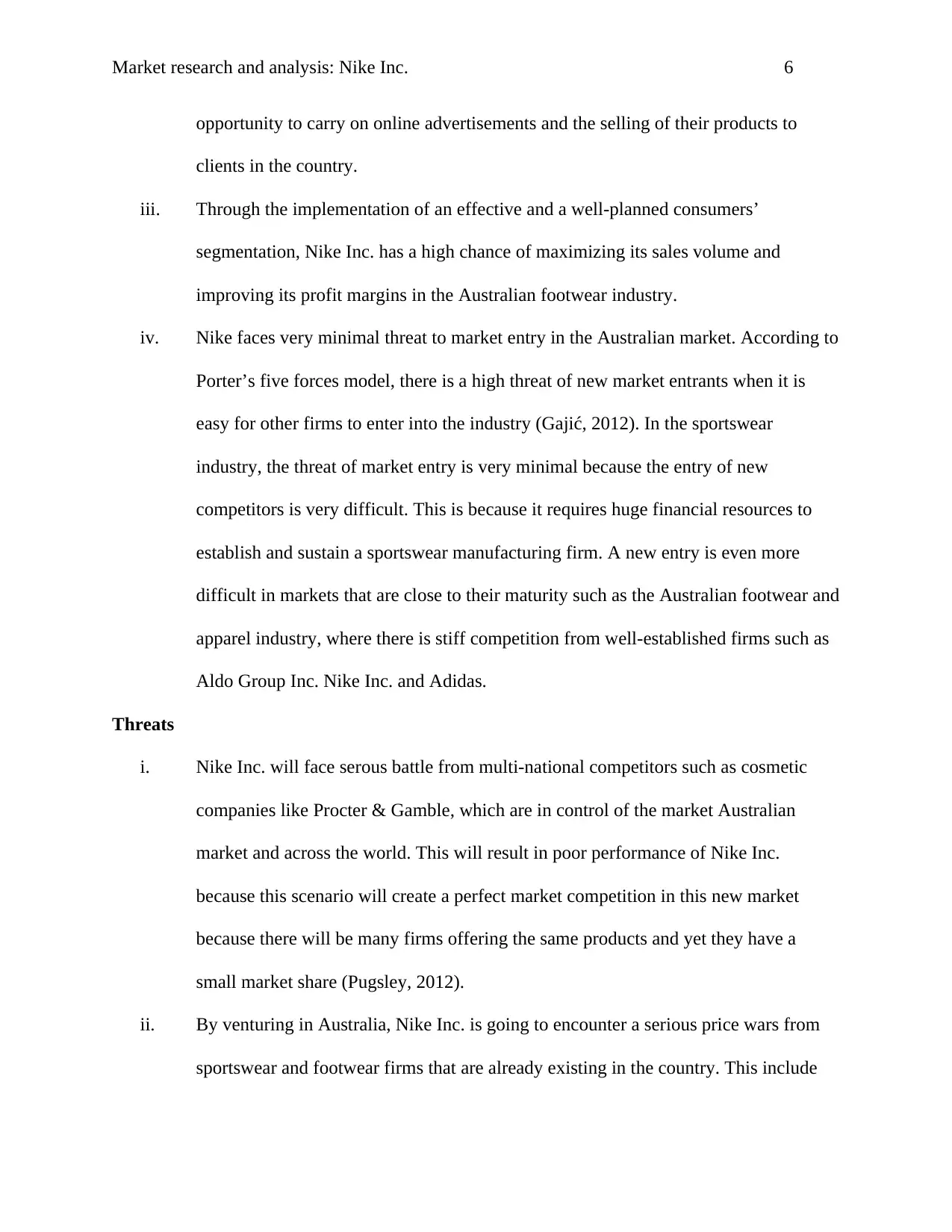
Market research and analysis: Nike Inc. 6
opportunity to carry on online advertisements and the selling of their products to
clients in the country.
iii. Through the implementation of an effective and a well-planned consumers’
segmentation, Nike Inc. has a high chance of maximizing its sales volume and
improving its profit margins in the Australian footwear industry.
iv. Nike faces very minimal threat to market entry in the Australian market. According to
Porter’s five forces model, there is a high threat of new market entrants when it is
easy for other firms to enter into the industry (Gajić, 2012). In the sportswear
industry, the threat of market entry is very minimal because the entry of new
competitors is very difficult. This is because it requires huge financial resources to
establish and sustain a sportswear manufacturing firm. A new entry is even more
difficult in markets that are close to their maturity such as the Australian footwear and
apparel industry, where there is stiff competition from well-established firms such as
Aldo Group Inc. Nike Inc. and Adidas.
Threats
i. Nike Inc. will face serous battle from multi-national competitors such as cosmetic
companies like Procter & Gamble, which are in control of the market Australian
market and across the world. This will result in poor performance of Nike Inc.
because this scenario will create a perfect market competition in this new market
because there will be many firms offering the same products and yet they have a
small market share (Pugsley, 2012).
ii. By venturing in Australia, Nike Inc. is going to encounter a serious price wars from
sportswear and footwear firms that are already existing in the country. This include
opportunity to carry on online advertisements and the selling of their products to
clients in the country.
iii. Through the implementation of an effective and a well-planned consumers’
segmentation, Nike Inc. has a high chance of maximizing its sales volume and
improving its profit margins in the Australian footwear industry.
iv. Nike faces very minimal threat to market entry in the Australian market. According to
Porter’s five forces model, there is a high threat of new market entrants when it is
easy for other firms to enter into the industry (Gajić, 2012). In the sportswear
industry, the threat of market entry is very minimal because the entry of new
competitors is very difficult. This is because it requires huge financial resources to
establish and sustain a sportswear manufacturing firm. A new entry is even more
difficult in markets that are close to their maturity such as the Australian footwear and
apparel industry, where there is stiff competition from well-established firms such as
Aldo Group Inc. Nike Inc. and Adidas.
Threats
i. Nike Inc. will face serous battle from multi-national competitors such as cosmetic
companies like Procter & Gamble, which are in control of the market Australian
market and across the world. This will result in poor performance of Nike Inc.
because this scenario will create a perfect market competition in this new market
because there will be many firms offering the same products and yet they have a
small market share (Pugsley, 2012).
ii. By venturing in Australia, Nike Inc. is going to encounter a serious price wars from
sportswear and footwear firms that are already existing in the country. This include
⊘ This is a preview!⊘
Do you want full access?
Subscribe today to unlock all pages.

Trusted by 1+ million students worldwide
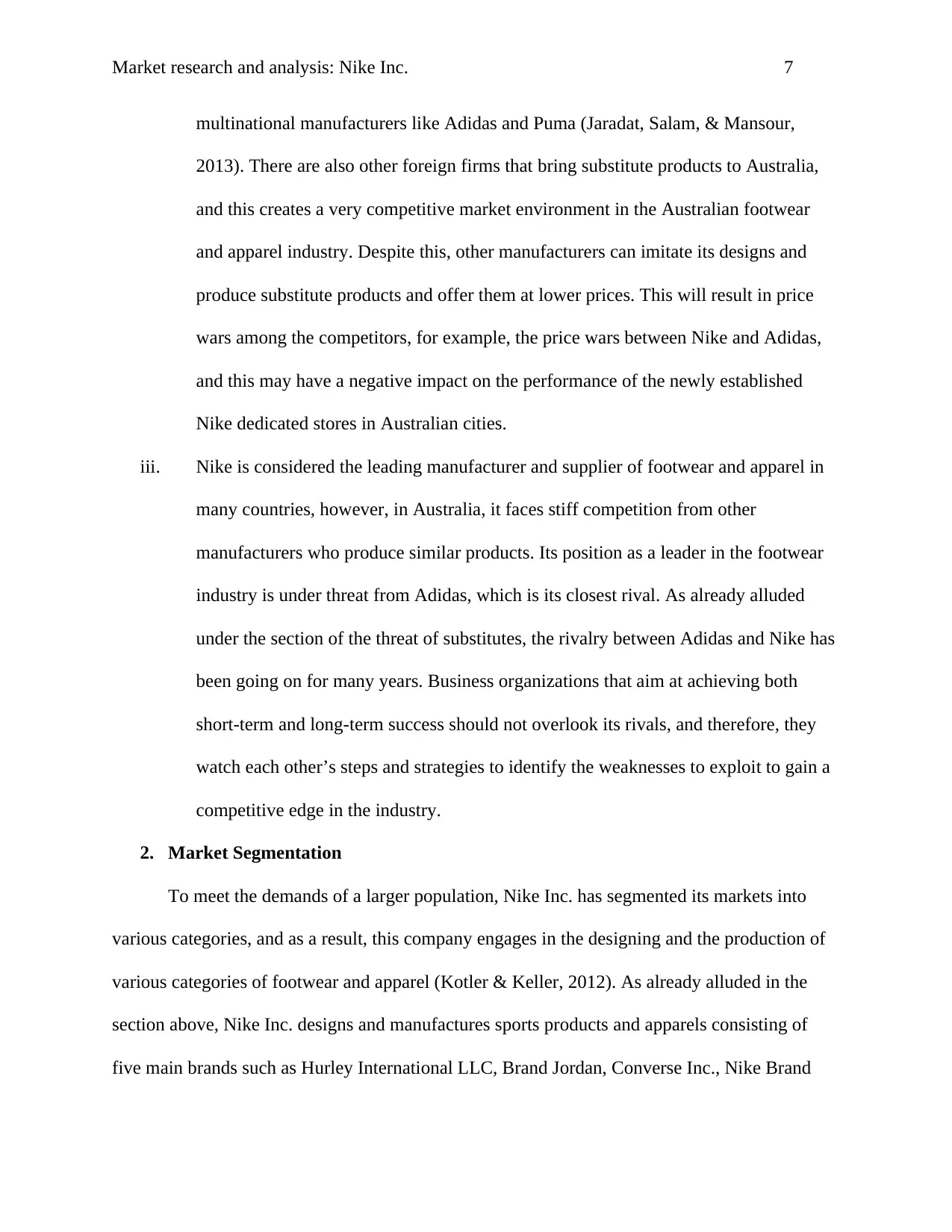
Market research and analysis: Nike Inc. 7
multinational manufacturers like Adidas and Puma (Jaradat, Salam, & Mansour,
2013). There are also other foreign firms that bring substitute products to Australia,
and this creates a very competitive market environment in the Australian footwear
and apparel industry. Despite this, other manufacturers can imitate its designs and
produce substitute products and offer them at lower prices. This will result in price
wars among the competitors, for example, the price wars between Nike and Adidas,
and this may have a negative impact on the performance of the newly established
Nike dedicated stores in Australian cities.
iii. Nike is considered the leading manufacturer and supplier of footwear and apparel in
many countries, however, in Australia, it faces stiff competition from other
manufacturers who produce similar products. Its position as a leader in the footwear
industry is under threat from Adidas, which is its closest rival. As already alluded
under the section of the threat of substitutes, the rivalry between Adidas and Nike has
been going on for many years. Business organizations that aim at achieving both
short-term and long-term success should not overlook its rivals, and therefore, they
watch each other’s steps and strategies to identify the weaknesses to exploit to gain a
competitive edge in the industry.
2. Market Segmentation
To meet the demands of a larger population, Nike Inc. has segmented its markets into
various categories, and as a result, this company engages in the designing and the production of
various categories of footwear and apparel (Kotler & Keller, 2012). As already alluded in the
section above, Nike Inc. designs and manufactures sports products and apparels consisting of
five main brands such as Hurley International LLC, Brand Jordan, Converse Inc., Nike Brand
multinational manufacturers like Adidas and Puma (Jaradat, Salam, & Mansour,
2013). There are also other foreign firms that bring substitute products to Australia,
and this creates a very competitive market environment in the Australian footwear
and apparel industry. Despite this, other manufacturers can imitate its designs and
produce substitute products and offer them at lower prices. This will result in price
wars among the competitors, for example, the price wars between Nike and Adidas,
and this may have a negative impact on the performance of the newly established
Nike dedicated stores in Australian cities.
iii. Nike is considered the leading manufacturer and supplier of footwear and apparel in
many countries, however, in Australia, it faces stiff competition from other
manufacturers who produce similar products. Its position as a leader in the footwear
industry is under threat from Adidas, which is its closest rival. As already alluded
under the section of the threat of substitutes, the rivalry between Adidas and Nike has
been going on for many years. Business organizations that aim at achieving both
short-term and long-term success should not overlook its rivals, and therefore, they
watch each other’s steps and strategies to identify the weaknesses to exploit to gain a
competitive edge in the industry.
2. Market Segmentation
To meet the demands of a larger population, Nike Inc. has segmented its markets into
various categories, and as a result, this company engages in the designing and the production of
various categories of footwear and apparel (Kotler & Keller, 2012). As already alluded in the
section above, Nike Inc. designs and manufactures sports products and apparels consisting of
five main brands such as Hurley International LLC, Brand Jordan, Converse Inc., Nike Brand
Paraphrase This Document
Need a fresh take? Get an instant paraphrase of this document with our AI Paraphraser
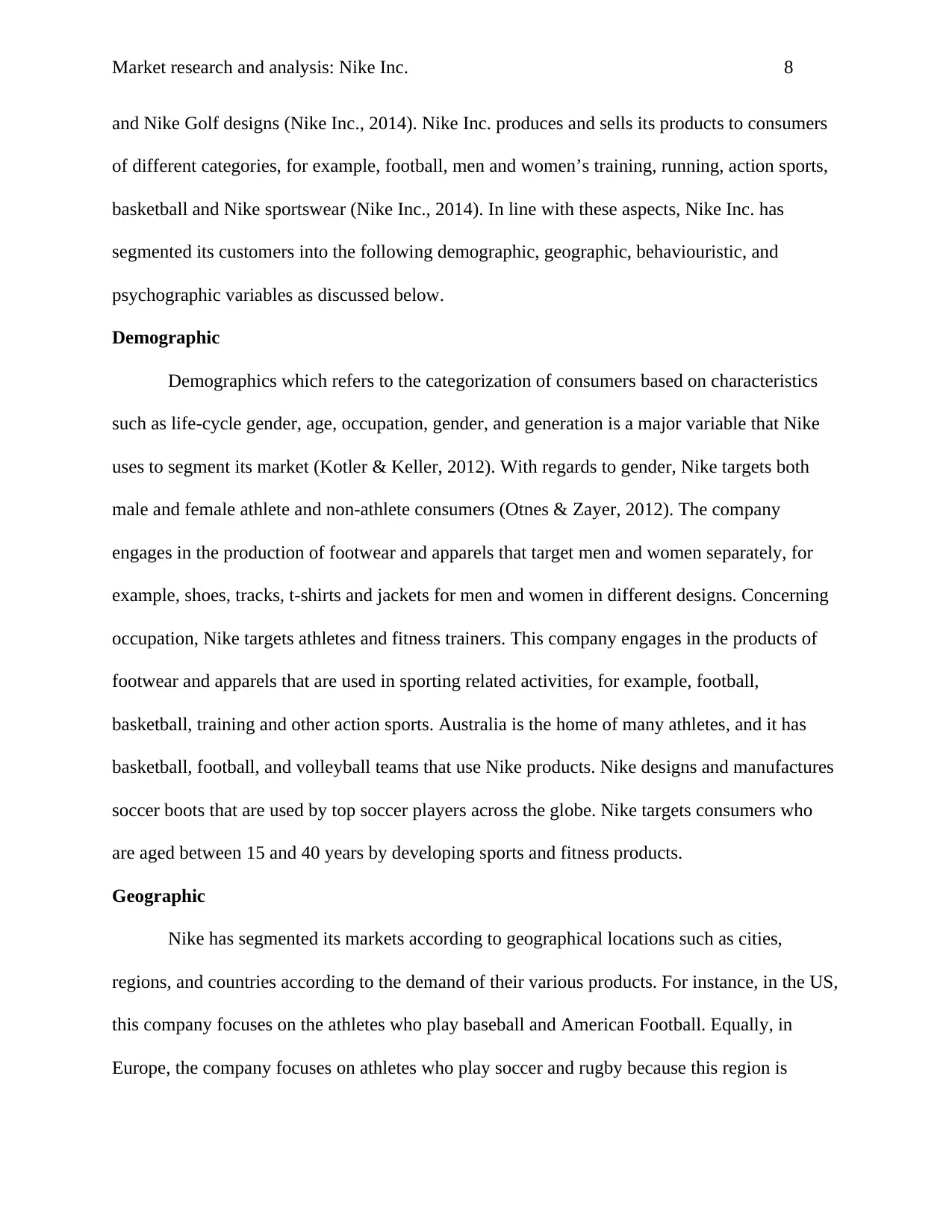
Market research and analysis: Nike Inc. 8
and Nike Golf designs (Nike Inc., 2014). Nike Inc. produces and sells its products to consumers
of different categories, for example, football, men and women’s training, running, action sports,
basketball and Nike sportswear (Nike Inc., 2014). In line with these aspects, Nike Inc. has
segmented its customers into the following demographic, geographic, behaviouristic, and
psychographic variables as discussed below.
Demographic
Demographics which refers to the categorization of consumers based on characteristics
such as life-cycle gender, age, occupation, gender, and generation is a major variable that Nike
uses to segment its market (Kotler & Keller, 2012). With regards to gender, Nike targets both
male and female athlete and non-athlete consumers (Otnes & Zayer, 2012). The company
engages in the production of footwear and apparels that target men and women separately, for
example, shoes, tracks, t-shirts and jackets for men and women in different designs. Concerning
occupation, Nike targets athletes and fitness trainers. This company engages in the products of
footwear and apparels that are used in sporting related activities, for example, football,
basketball, training and other action sports. Australia is the home of many athletes, and it has
basketball, football, and volleyball teams that use Nike products. Nike designs and manufactures
soccer boots that are used by top soccer players across the globe. Nike targets consumers who
are aged between 15 and 40 years by developing sports and fitness products.
Geographic
Nike has segmented its markets according to geographical locations such as cities,
regions, and countries according to the demand of their various products. For instance, in the US,
this company focuses on the athletes who play baseball and American Football. Equally, in
Europe, the company focuses on athletes who play soccer and rugby because this region is
and Nike Golf designs (Nike Inc., 2014). Nike Inc. produces and sells its products to consumers
of different categories, for example, football, men and women’s training, running, action sports,
basketball and Nike sportswear (Nike Inc., 2014). In line with these aspects, Nike Inc. has
segmented its customers into the following demographic, geographic, behaviouristic, and
psychographic variables as discussed below.
Demographic
Demographics which refers to the categorization of consumers based on characteristics
such as life-cycle gender, age, occupation, gender, and generation is a major variable that Nike
uses to segment its market (Kotler & Keller, 2012). With regards to gender, Nike targets both
male and female athlete and non-athlete consumers (Otnes & Zayer, 2012). The company
engages in the production of footwear and apparels that target men and women separately, for
example, shoes, tracks, t-shirts and jackets for men and women in different designs. Concerning
occupation, Nike targets athletes and fitness trainers. This company engages in the products of
footwear and apparels that are used in sporting related activities, for example, football,
basketball, training and other action sports. Australia is the home of many athletes, and it has
basketball, football, and volleyball teams that use Nike products. Nike designs and manufactures
soccer boots that are used by top soccer players across the globe. Nike targets consumers who
are aged between 15 and 40 years by developing sports and fitness products.
Geographic
Nike has segmented its markets according to geographical locations such as cities,
regions, and countries according to the demand of their various products. For instance, in the US,
this company focuses on the athletes who play baseball and American Football. Equally, in
Europe, the company focuses on athletes who play soccer and rugby because this region is
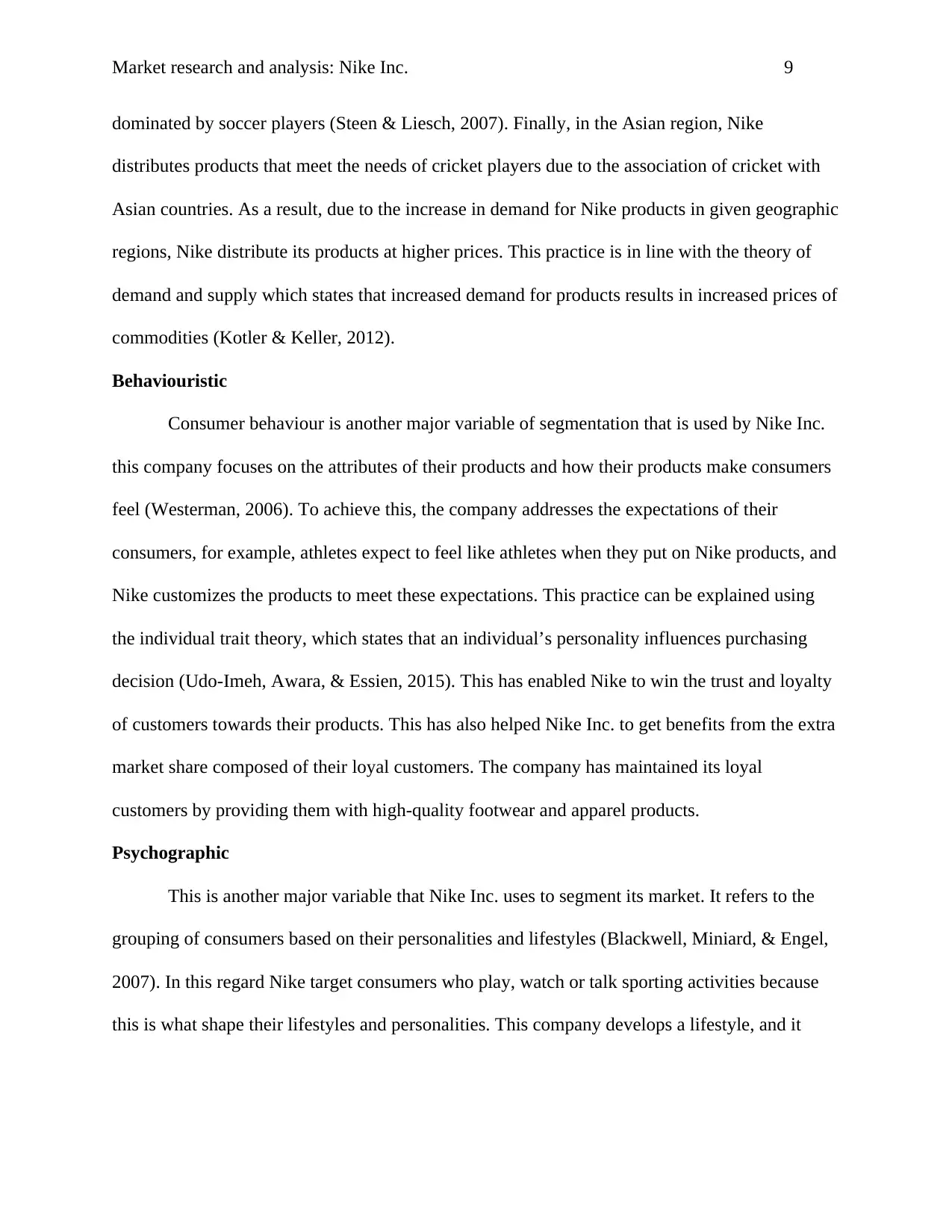
Market research and analysis: Nike Inc. 9
dominated by soccer players (Steen & Liesch, 2007). Finally, in the Asian region, Nike
distributes products that meet the needs of cricket players due to the association of cricket with
Asian countries. As a result, due to the increase in demand for Nike products in given geographic
regions, Nike distribute its products at higher prices. This practice is in line with the theory of
demand and supply which states that increased demand for products results in increased prices of
commodities (Kotler & Keller, 2012).
Behaviouristic
Consumer behaviour is another major variable of segmentation that is used by Nike Inc.
this company focuses on the attributes of their products and how their products make consumers
feel (Westerman, 2006). To achieve this, the company addresses the expectations of their
consumers, for example, athletes expect to feel like athletes when they put on Nike products, and
Nike customizes the products to meet these expectations. This practice can be explained using
the individual trait theory, which states that an individual’s personality influences purchasing
decision (Udo-Imeh, Awara, & Essien, 2015). This has enabled Nike to win the trust and loyalty
of customers towards their products. This has also helped Nike Inc. to get benefits from the extra
market share composed of their loyal customers. The company has maintained its loyal
customers by providing them with high-quality footwear and apparel products.
Psychographic
This is another major variable that Nike Inc. uses to segment its market. It refers to the
grouping of consumers based on their personalities and lifestyles (Blackwell, Miniard, & Engel,
2007). In this regard Nike target consumers who play, watch or talk sporting activities because
this is what shape their lifestyles and personalities. This company develops a lifestyle, and it
dominated by soccer players (Steen & Liesch, 2007). Finally, in the Asian region, Nike
distributes products that meet the needs of cricket players due to the association of cricket with
Asian countries. As a result, due to the increase in demand for Nike products in given geographic
regions, Nike distribute its products at higher prices. This practice is in line with the theory of
demand and supply which states that increased demand for products results in increased prices of
commodities (Kotler & Keller, 2012).
Behaviouristic
Consumer behaviour is another major variable of segmentation that is used by Nike Inc.
this company focuses on the attributes of their products and how their products make consumers
feel (Westerman, 2006). To achieve this, the company addresses the expectations of their
consumers, for example, athletes expect to feel like athletes when they put on Nike products, and
Nike customizes the products to meet these expectations. This practice can be explained using
the individual trait theory, which states that an individual’s personality influences purchasing
decision (Udo-Imeh, Awara, & Essien, 2015). This has enabled Nike to win the trust and loyalty
of customers towards their products. This has also helped Nike Inc. to get benefits from the extra
market share composed of their loyal customers. The company has maintained its loyal
customers by providing them with high-quality footwear and apparel products.
Psychographic
This is another major variable that Nike Inc. uses to segment its market. It refers to the
grouping of consumers based on their personalities and lifestyles (Blackwell, Miniard, & Engel,
2007). In this regard Nike target consumers who play, watch or talk sporting activities because
this is what shape their lifestyles and personalities. This company develops a lifestyle, and it
⊘ This is a preview!⊘
Do you want full access?
Subscribe today to unlock all pages.

Trusted by 1+ million students worldwide
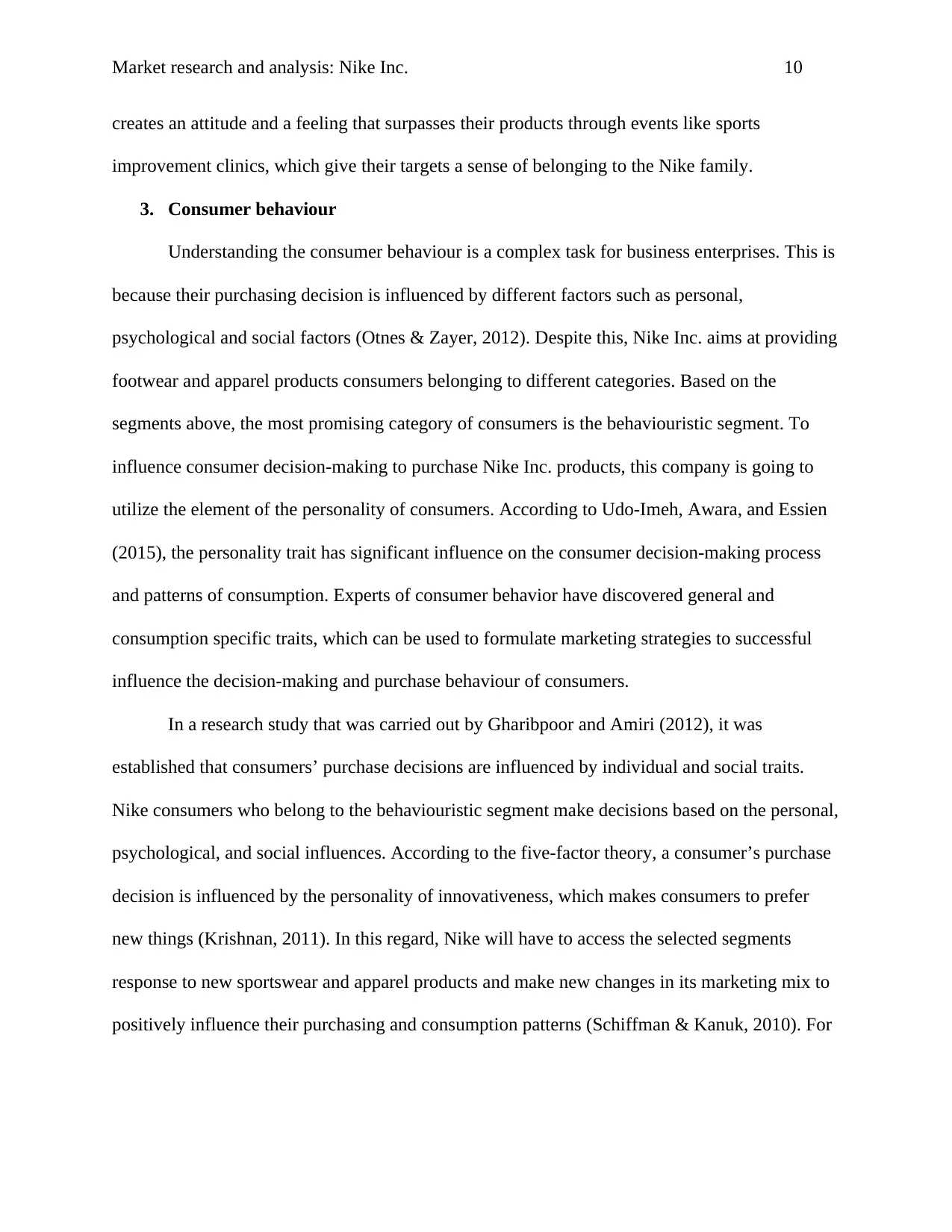
Market research and analysis: Nike Inc. 10
creates an attitude and a feeling that surpasses their products through events like sports
improvement clinics, which give their targets a sense of belonging to the Nike family.
3. Consumer behaviour
Understanding the consumer behaviour is a complex task for business enterprises. This is
because their purchasing decision is influenced by different factors such as personal,
psychological and social factors (Otnes & Zayer, 2012). Despite this, Nike Inc. aims at providing
footwear and apparel products consumers belonging to different categories. Based on the
segments above, the most promising category of consumers is the behaviouristic segment. To
influence consumer decision-making to purchase Nike Inc. products, this company is going to
utilize the element of the personality of consumers. According to Udo-Imeh, Awara, and Essien
(2015), the personality trait has significant influence on the consumer decision-making process
and patterns of consumption. Experts of consumer behavior have discovered general and
consumption specific traits, which can be used to formulate marketing strategies to successful
influence the decision-making and purchase behaviour of consumers.
In a research study that was carried out by Gharibpoor and Amiri (2012), it was
established that consumers’ purchase decisions are influenced by individual and social traits.
Nike consumers who belong to the behaviouristic segment make decisions based on the personal,
psychological, and social influences. According to the five-factor theory, a consumer’s purchase
decision is influenced by the personality of innovativeness, which makes consumers to prefer
new things (Krishnan, 2011). In this regard, Nike will have to access the selected segments
response to new sportswear and apparel products and make new changes in its marketing mix to
positively influence their purchasing and consumption patterns (Schiffman & Kanuk, 2010). For
creates an attitude and a feeling that surpasses their products through events like sports
improvement clinics, which give their targets a sense of belonging to the Nike family.
3. Consumer behaviour
Understanding the consumer behaviour is a complex task for business enterprises. This is
because their purchasing decision is influenced by different factors such as personal,
psychological and social factors (Otnes & Zayer, 2012). Despite this, Nike Inc. aims at providing
footwear and apparel products consumers belonging to different categories. Based on the
segments above, the most promising category of consumers is the behaviouristic segment. To
influence consumer decision-making to purchase Nike Inc. products, this company is going to
utilize the element of the personality of consumers. According to Udo-Imeh, Awara, and Essien
(2015), the personality trait has significant influence on the consumer decision-making process
and patterns of consumption. Experts of consumer behavior have discovered general and
consumption specific traits, which can be used to formulate marketing strategies to successful
influence the decision-making and purchase behaviour of consumers.
In a research study that was carried out by Gharibpoor and Amiri (2012), it was
established that consumers’ purchase decisions are influenced by individual and social traits.
Nike consumers who belong to the behaviouristic segment make decisions based on the personal,
psychological, and social influences. According to the five-factor theory, a consumer’s purchase
decision is influenced by the personality of innovativeness, which makes consumers to prefer
new things (Krishnan, 2011). In this regard, Nike will have to access the selected segments
response to new sportswear and apparel products and make new changes in its marketing mix to
positively influence their purchasing and consumption patterns (Schiffman & Kanuk, 2010). For
Paraphrase This Document
Need a fresh take? Get an instant paraphrase of this document with our AI Paraphraser
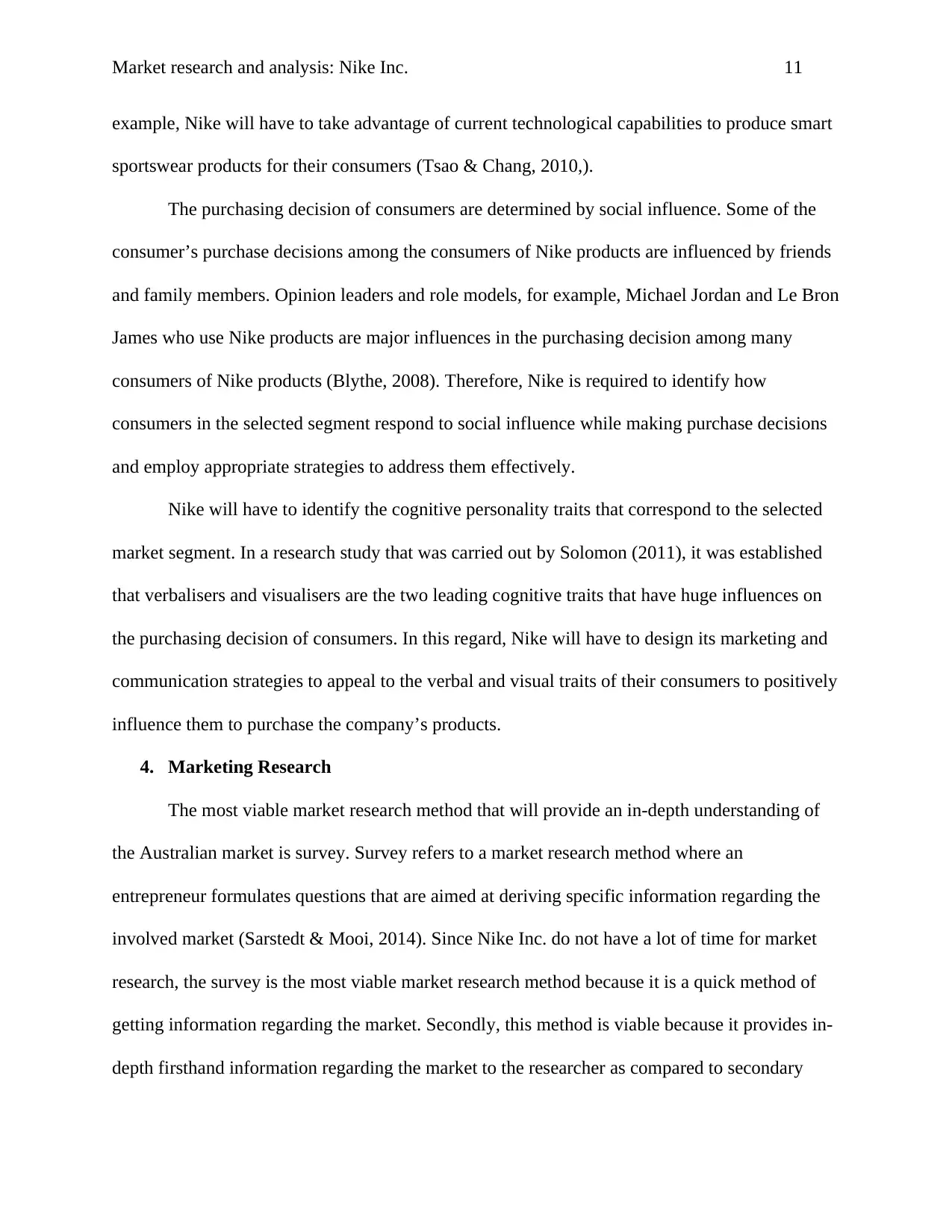
Market research and analysis: Nike Inc. 11
example, Nike will have to take advantage of current technological capabilities to produce smart
sportswear products for their consumers (Tsao & Chang, 2010,).
The purchasing decision of consumers are determined by social influence. Some of the
consumer’s purchase decisions among the consumers of Nike products are influenced by friends
and family members. Opinion leaders and role models, for example, Michael Jordan and Le Bron
James who use Nike products are major influences in the purchasing decision among many
consumers of Nike products (Blythe, 2008). Therefore, Nike is required to identify how
consumers in the selected segment respond to social influence while making purchase decisions
and employ appropriate strategies to address them effectively.
Nike will have to identify the cognitive personality traits that correspond to the selected
market segment. In a research study that was carried out by Solomon (2011), it was established
that verbalisers and visualisers are the two leading cognitive traits that have huge influences on
the purchasing decision of consumers. In this regard, Nike will have to design its marketing and
communication strategies to appeal to the verbal and visual traits of their consumers to positively
influence them to purchase the company’s products.
4. Marketing Research
The most viable market research method that will provide an in-depth understanding of
the Australian market is survey. Survey refers to a market research method where an
entrepreneur formulates questions that are aimed at deriving specific information regarding the
involved market (Sarstedt & Mooi, 2014). Since Nike Inc. do not have a lot of time for market
research, the survey is the most viable market research method because it is a quick method of
getting information regarding the market. Secondly, this method is viable because it provides in-
depth firsthand information regarding the market to the researcher as compared to secondary
example, Nike will have to take advantage of current technological capabilities to produce smart
sportswear products for their consumers (Tsao & Chang, 2010,).
The purchasing decision of consumers are determined by social influence. Some of the
consumer’s purchase decisions among the consumers of Nike products are influenced by friends
and family members. Opinion leaders and role models, for example, Michael Jordan and Le Bron
James who use Nike products are major influences in the purchasing decision among many
consumers of Nike products (Blythe, 2008). Therefore, Nike is required to identify how
consumers in the selected segment respond to social influence while making purchase decisions
and employ appropriate strategies to address them effectively.
Nike will have to identify the cognitive personality traits that correspond to the selected
market segment. In a research study that was carried out by Solomon (2011), it was established
that verbalisers and visualisers are the two leading cognitive traits that have huge influences on
the purchasing decision of consumers. In this regard, Nike will have to design its marketing and
communication strategies to appeal to the verbal and visual traits of their consumers to positively
influence them to purchase the company’s products.
4. Marketing Research
The most viable market research method that will provide an in-depth understanding of
the Australian market is survey. Survey refers to a market research method where an
entrepreneur formulates questions that are aimed at deriving specific information regarding the
involved market (Sarstedt & Mooi, 2014). Since Nike Inc. do not have a lot of time for market
research, the survey is the most viable market research method because it is a quick method of
getting information regarding the market. Secondly, this method is viable because it provides in-
depth firsthand information regarding the market to the researcher as compared to secondary
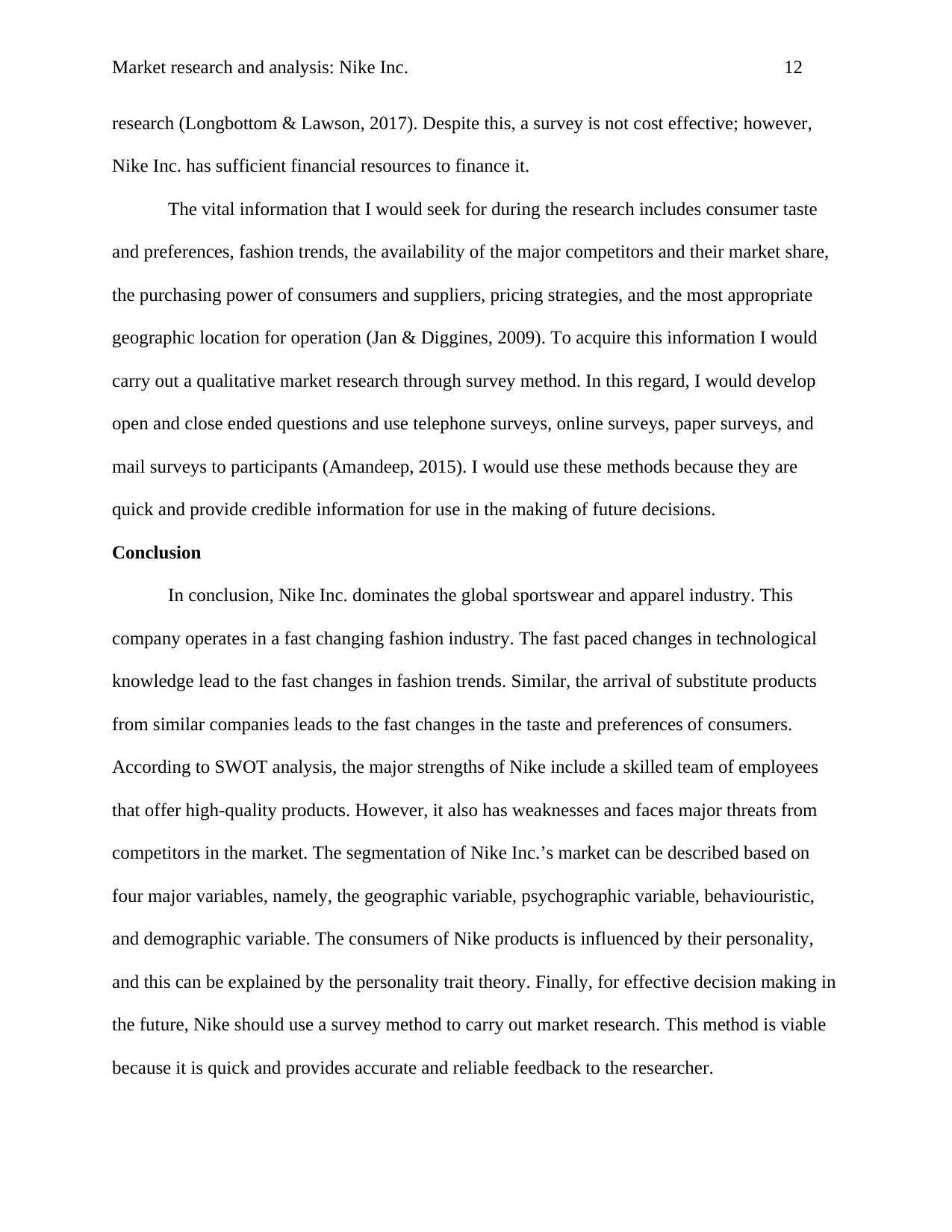
Market research and analysis: Nike Inc. 12
research (Longbottom & Lawson, 2017). Despite this, a survey is not cost effective; however,
Nike Inc. has sufficient financial resources to finance it.
The vital information that I would seek for during the research includes consumer taste
and preferences, fashion trends, the availability of the major competitors and their market share,
the purchasing power of consumers and suppliers, pricing strategies, and the most appropriate
geographic location for operation (Jan & Diggines, 2009). To acquire this information I would
carry out a qualitative market research through survey method. In this regard, I would develop
open and close ended questions and use telephone surveys, online surveys, paper surveys, and
mail surveys to participants (Amandeep, 2015). I would use these methods because they are
quick and provide credible information for use in the making of future decisions.
Conclusion
In conclusion, Nike Inc. dominates the global sportswear and apparel industry. This
company operates in a fast changing fashion industry. The fast paced changes in technological
knowledge lead to the fast changes in fashion trends. Similar, the arrival of substitute products
from similar companies leads to the fast changes in the taste and preferences of consumers.
According to SWOT analysis, the major strengths of Nike include a skilled team of employees
that offer high-quality products. However, it also has weaknesses and faces major threats from
competitors in the market. The segmentation of Nike Inc.’s market can be described based on
four major variables, namely, the geographic variable, psychographic variable, behaviouristic,
and demographic variable. The consumers of Nike products is influenced by their personality,
and this can be explained by the personality trait theory. Finally, for effective decision making in
the future, Nike should use a survey method to carry out market research. This method is viable
because it is quick and provides accurate and reliable feedback to the researcher.
research (Longbottom & Lawson, 2017). Despite this, a survey is not cost effective; however,
Nike Inc. has sufficient financial resources to finance it.
The vital information that I would seek for during the research includes consumer taste
and preferences, fashion trends, the availability of the major competitors and their market share,
the purchasing power of consumers and suppliers, pricing strategies, and the most appropriate
geographic location for operation (Jan & Diggines, 2009). To acquire this information I would
carry out a qualitative market research through survey method. In this regard, I would develop
open and close ended questions and use telephone surveys, online surveys, paper surveys, and
mail surveys to participants (Amandeep, 2015). I would use these methods because they are
quick and provide credible information for use in the making of future decisions.
Conclusion
In conclusion, Nike Inc. dominates the global sportswear and apparel industry. This
company operates in a fast changing fashion industry. The fast paced changes in technological
knowledge lead to the fast changes in fashion trends. Similar, the arrival of substitute products
from similar companies leads to the fast changes in the taste and preferences of consumers.
According to SWOT analysis, the major strengths of Nike include a skilled team of employees
that offer high-quality products. However, it also has weaknesses and faces major threats from
competitors in the market. The segmentation of Nike Inc.’s market can be described based on
four major variables, namely, the geographic variable, psychographic variable, behaviouristic,
and demographic variable. The consumers of Nike products is influenced by their personality,
and this can be explained by the personality trait theory. Finally, for effective decision making in
the future, Nike should use a survey method to carry out market research. This method is viable
because it is quick and provides accurate and reliable feedback to the researcher.
⊘ This is a preview!⊘
Do you want full access?
Subscribe today to unlock all pages.

Trusted by 1+ million students worldwide
1 out of 15
Related Documents
Your All-in-One AI-Powered Toolkit for Academic Success.
+13062052269
info@desklib.com
Available 24*7 on WhatsApp / Email
![[object Object]](/_next/static/media/star-bottom.7253800d.svg)
Unlock your academic potential
Copyright © 2020–2025 A2Z Services. All Rights Reserved. Developed and managed by ZUCOL.





